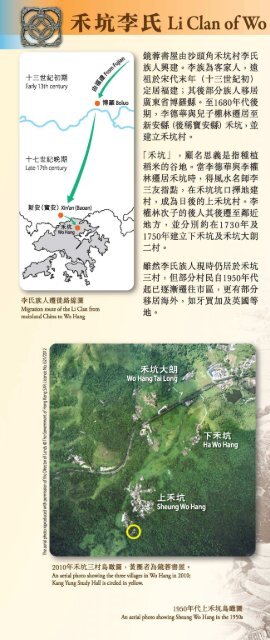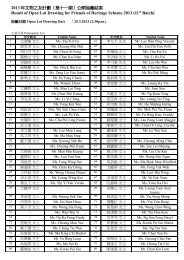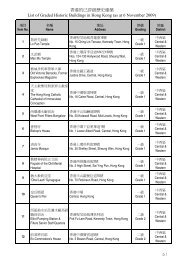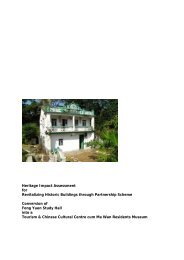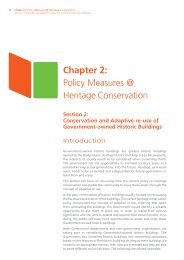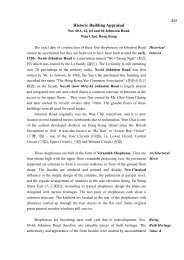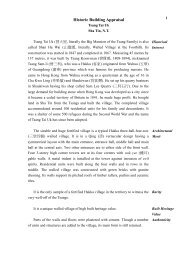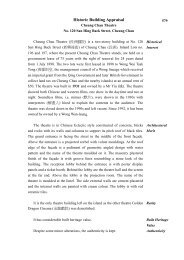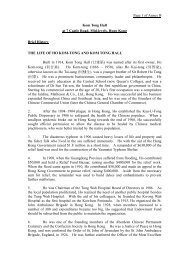Kang Yung Study Hall (revised in Sep 2010)
Kang Yung Study Hall (revised in Sep 2010)
Kang Yung Study Hall (revised in Sep 2010)
Create successful ePaper yourself
Turn your PDF publications into a flip-book with our unique Google optimized e-Paper software.
~ #L ~ ,re Li Clan ofWo Hang<br />
+-=t!t~cMWl<br />
Early 13th century<br />
+ -t t!t ~cat Wl<br />
Late 17th century<br />
fi<br />
~<br />
0<br />
•'-§>~<br />
e ltEBoluo<br />
-~-~83t:Pmt~7KtJt;f;f$:~<br />
~A-~o:$~~~*A'~<br />
fll~*ft*!f: (-t~ttUC.1JJ)<br />
J-Em11~;Jt~$%~A~m<br />
JlJ!t~iW/.Iti<br />
0<br />
~1680!f:ft~<br />
M'*••~~rttif*ilm~<br />
m1(ti (~~Jl1(ti) 7KtJL, .ML<br />
~:f[7KtJct-fo<br />
17Kf1LJ , ~~~ ,'it',fH!~11:ft<br />
;m*I¥J~:lif!o]f:$1l-~*·<br />
if*ilm7KtJcffif , 1~M7.K~ '*P*<br />
~it~~~ ' 1£7KfJtfJt tl~:li!!~<br />
t-f,JV(;~I3~1¥JL7KtJct-fo:$<br />
ttif*rxri¥1~AJt~il~~lli<br />
:li!!:lJ, ~%~U.r.J1£173o!f:li<br />
1 7 so!¥ ~:fl. r 7Kf1Lli7Kf1L:X ~<br />
=t-fo<br />
The <strong>Kang</strong> <strong>Yung</strong> <strong>Study</strong> <strong>Hall</strong> was founded by the Li Clan ofWo Hang Village <strong>in</strong><br />
Sha Tau Kok. The ancestors of this Hakka clan had settled <strong>in</strong> Fujian prov<strong>in</strong>ce at<br />
the end of the Song dynasty (early 13th century), and some of their descendants<br />
later migrated to Boluo county <strong>in</strong> Guangdong prov<strong>in</strong>ce. In the late 1680s, Li<br />
Tak-wah and his son Li Kuen-lam moved from Boluo to Wo Hang <strong>in</strong> X<strong>in</strong>'an<br />
county (later renamed Baoan), where they laid the foundations for the village.<br />
Wo Hang literally means "valley of rice". When Li Tak-wah and Li Kuen-lam<br />
moved to the area, they took the advice of Li Sam-yau, a feng shui expert, and<br />
established their village near the mouth of the valley. This village was then called<br />
Sheung Wo Hang (Upper Wo Hang). The descendants ofKuen-lam's second son<br />
branched out to found two other villages, Ha Wo Hang (Lower Wo Hang) and<br />
Wo Hang Tai Long, <strong>in</strong> around 1730 and 1750 respectively.<br />
Descendants of the Li Clan still reside <strong>in</strong> these three villages <strong>in</strong> Wo Hang today,<br />
although s<strong>in</strong>ce the 1950s many have moved to urban areas <strong>in</strong> Hong Kong and<br />
even abroad, mostly to Jamaica and England.<br />
* ~:ti*.AJI:ft~~ Iii<br />
Migration route of the Li Clan from<br />
ma<strong>in</strong>land Ch<strong>in</strong>a to Wo Hang<br />
it&*~~Amffif1J3m~7KtJL<br />
~t-t ' 1.§. $%t-f ~ § 1950!f:ft<br />
®B~*ilf±rlllii,]!:ff$%<br />
~mtflt5tr<br />
:lif!o<br />
, ~of~1Joli~~~~<br />
<strong>2010</strong>~%;:1;Jt.:::;ft,~~lii ' itll!~f.ig·~-~ 0<br />
An aerial photo show<strong>in</strong>g the three villages <strong>in</strong> Wo Hang <strong>in</strong> <strong>2010</strong>;<br />
<strong>Kang</strong> <strong>Yung</strong> <strong>Study</strong> <strong>Hall</strong> is circled <strong>in</strong> yellow.<br />
An aerial photo show<strong>in</strong>g Sheung Wo Hang <strong>in</strong> the 1950s


